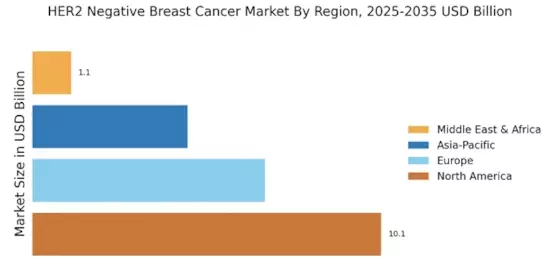Increase in Incidence Rates
The HER2 Negative Breast Cancer Market is experiencing a notable increase in incidence rates, which appears to be driven by various factors including lifestyle changes and environmental influences. According to recent data, the incidence of breast cancer has been rising steadily, with HER2 negative cases accounting for a significant proportion of new diagnoses. This trend suggests a growing patient population that necessitates innovative treatment options and supportive care. As healthcare systems adapt to these rising numbers, the demand for targeted therapies and personalized medicine is likely to expand, thereby propelling the HER2 Negative Breast Cancer Market forward. Furthermore, the increasing awareness of breast cancer symptoms and the importance of regular screenings may contribute to earlier detection, ultimately influencing treatment pathways and market dynamics.
Emergence of Combination Therapies
The HER2 Negative Breast Cancer Market is witnessing a notable trend towards the emergence of combination therapies. Recent clinical evidence suggests that combining different treatment modalities, such as chemotherapy with targeted therapies, may enhance therapeutic efficacy and improve patient outcomes. This approach is particularly relevant for HER2 negative breast cancer, where treatment options have historically been limited. The growing body of research supporting combination therapies is likely to drive market growth, as healthcare providers seek to optimize treatment regimens for their patients. Additionally, the increasing number of clinical trials exploring these combinations indicates a robust pipeline of potential therapies that could reshape the HER2 Negative Breast Cancer Market in the coming years.
Growing Patient Advocacy and Awareness
The HER2 Negative Breast Cancer Market is benefiting from a surge in patient advocacy and awareness initiatives. Organizations dedicated to breast cancer awareness are actively promoting education about HER2 negative breast cancer, which is crucial for early detection and treatment. This heightened awareness is leading to increased patient engagement in treatment decisions and a demand for more personalized care options. Furthermore, advocacy groups are influencing policy changes that support research funding and access to innovative therapies. As patients become more informed about their condition, the market is likely to see a shift towards more comprehensive treatment approaches, thereby enhancing the overall landscape of the HER2 Negative Breast Cancer Market.
Advancements in Research and Development
The HER2 Negative Breast Cancer Market is significantly influenced by ongoing advancements in research and development. Pharmaceutical companies and research institutions are increasingly investing in the discovery of novel therapeutic agents and treatment modalities. Recent studies have indicated that targeted therapies, including those focusing on specific genetic mutations, are showing promise in improving patient outcomes. The market is witnessing a surge in clinical trials aimed at evaluating the efficacy of these new treatments, which could potentially reshape the therapeutic landscape for HER2 negative breast cancer. As a result, the influx of innovative therapies is likely to enhance the competitive environment within the HER2 Negative Breast Cancer Market, attracting further investment and collaboration among stakeholders.
Regulatory Support for Innovative Treatments
The HER2 Negative Breast Cancer Market is experiencing a favorable regulatory environment that supports the development and approval of innovative treatments. Regulatory agencies are increasingly recognizing the need for expedited pathways for promising therapies, particularly those targeting unmet medical needs in breast cancer. This trend is evident in the approval of several novel agents that have shown efficacy in HER2 negative breast cancer. The proactive stance of regulatory bodies not only accelerates the availability of new treatments but also encourages pharmaceutical companies to invest in research and development. As a result, the HER2 Negative Breast Cancer Market is likely to benefit from a continuous influx of innovative therapies that address the diverse needs of patients.


















Leave a Comment